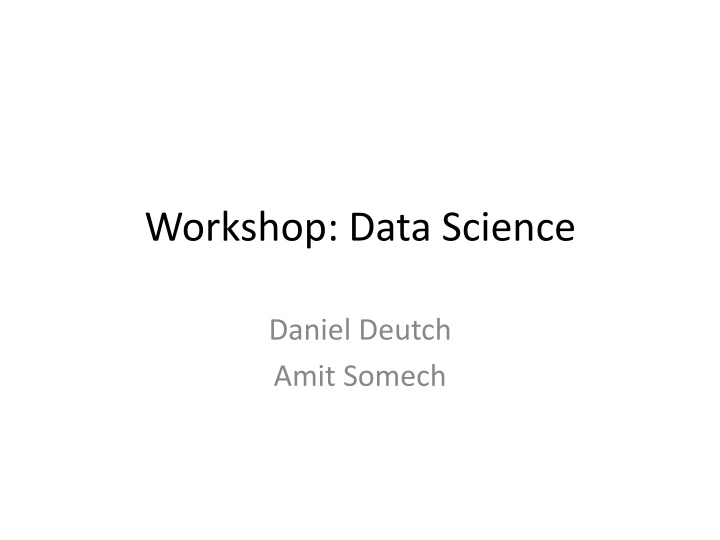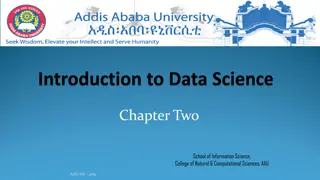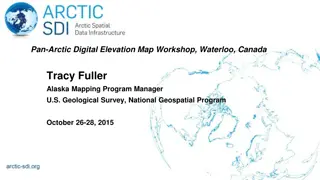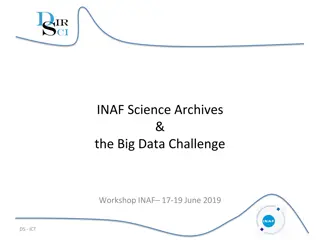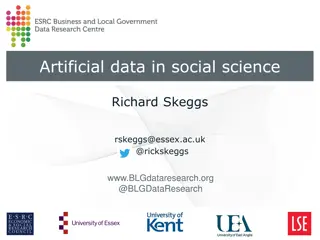Data Science Workshop Overview
Gain insights from data through a hands-on workshop focusing on basic components, identifying business goals, exploring data, and data preparation. Learn the interdisciplinary techniques required for successful data analysis and modeling.
Download Presentation

Please find below an Image/Link to download the presentation.
The content on the website is provided AS IS for your information and personal use only. It may not be sold, licensed, or shared on other websites without obtaining consent from the author.If you encounter any issues during the download, it is possible that the publisher has removed the file from their server.
You are allowed to download the files provided on this website for personal or commercial use, subject to the condition that they are used lawfully. All files are the property of their respective owners.
The content on the website is provided AS IS for your information and personal use only. It may not be sold, licensed, or shared on other websites without obtaining consent from the author.
E N D
Presentation Transcript
Workshop: Data Science Daniel Deutch Amit Somech
Data Science In one sentence: gain insights from data Either explain a phenomenon or trend or predict them Typically both Techniques include a mix from databases/data mining, Machine Learning and statistics Considered an interdisciplinary profession Somewhat of a buzz word, but one that is very hot in industry
DS Workshop The idea is to give you a taste of this important area Unlike a regular course, you learn ``hands-on Requires a lot of work, a lot of self-teaching We are here to guide you But it is your responsibility to push things forward We have some checkpoints in the schedule, but do not rely only on them! Make sure to have a viable plan and get our advice
Basic Components Source: Wikipedia
Basic Components Business undersrtanding, goal identification Getting and understanding the data Data preparation Visualization (optional, yet often useful) Modeling Feature Engineering Choice of (ML) Algorithms Initial Parameter Choice Model Training Evaluation
More details Identify a Business goal In companies: something that can bring value, usually monetary, to the company Forecasting demand Identifying fraud Explaining server failure Forecasting user clicks In this workshop: something that you find interesting!
Exploring data Find an appropriate dataset and explore it Start by looking at it (e.g. open a portion in Excel) Schema Data quality Availability Need for integration Apply some basic analysis In particular, basic feature extraction Represent each data item as a vector of features To begin with, features can simply be the basic table columns Visualization helps!
Data Preparation Types, format Data Integration (if needed) Data Distribution Correlations Outlier Detection Data Cleaning Missing values (NULLs), outliers/errors Normalization (scaling) Time consumable, not great fun, but highly important! Claimed to consume 80% of data scientists time
Data Integration If data originates in multiple sources, it will probably not be aligned Attribute names may be different (pname vs. personname, pid vs. personid) Format may be different (DD/MM/YY vs. DD/YY/MM) Structure may be different (by id vs. by name) Schema matching Some old but good surveys of basic techniques: http://dbs.uni-leipzig.de/file/VLDBJ-Dec2001.pdf http://disi.unitn.it/~p2p/RelatedWork/Matching/JoDS-IV- 2005_SurveyMatching-SE.pdf
Data Distribution Apply statistical tools to the data to identify its distribution, correlations between items An important case is that of time-series data Show how data evolves over time Seasonality is common, needs to be accounted for In general, knowing the distribution is important For prediction of new data points For outlier detection Types of correlations Pearson, Spearman, Kendall s tau, Important to identify correlation between features (e.g. based on Mutual Information - entropy) Will be highly useful for the model generation phase
Distribution Mean, median, most common value Skewness and Kurtosis Respectively, how assymetric or peaked relative to the normal distribution is the given distribution Testing the distribution Q-Q plot, Kolmogorov Smirnov test, others Other methods you have learned in Intro to Statistics
) Data Cleaning NULLs) Nulls are not uncommon Indicate missing information Trivial to identify How to handle? Remove/ignore the entire entry Sometimes OK, sometimes too brutal, depends on how many NULLs there are and on whether their distribution is skewed Complete based on: Correlations with other attributes (in turn learned for data items where the value is not NULL) Interpolation based on the distribution or similar records Sample based on the distribution
Data Cleaning (outliers) Much harder to identify, or even formally define Generally, look for points deviating from the data s general distribution Multiple outlier tests Grubbs, Dixon s Q-test, Rosners (look it up) Clustering-based Single vs. multiple outlier detection, univariate vs. multivariate distribution Many tools for R, Python, and others
Data Cleaning (outliers, cont.) Once identified, what to do with outliers? If there are few, check them (if very few, do it manually) If seem like errors, simply discard Otherwise may need a special treatment or adapting the distribution If there are many, perhaps the inferred distribution was not correct Apply tests
Normalization For many ML algorithms to work properly, need to have a uniform scale for all attributes Simple methods Normalization to [0,1] (x-min) / (max-min) Normalization to [-1,1] (2x-min-max) / (max-min) Statistical methods Z-normalization log-normalization
Discretization Some algorithms require discrete values The actual data may be non-numeric, or numeric but continous Also called binning sometimes Equal-length Based on the distribution Entropy-based (for non-numeric)
Visualization It is recommended to plot the data before, during and after preparation Use R, Matlab, Excel, Python libraries, or any other tool for that Useful to get a sense of what s going on For instance, you may see remaining outliers just by looking at the data! Eventually, also highly useful for your customers
Modeling Feature Engineering Choice of (ML) Algorithms Initial Parameter Choice
Feature Selection and Engineering Feature selection Goal: choose a subset of the features/attributes of the data Which of the attributes of the input are important for your goal? Which of the attributes have discriminatory power? Feature Engineering Generation of new features through transformations on the data
Training, Validation and Test set Common practice to divide the data to training , validation and test set Training data is used for feature engineering (and later model parameter inference) Validation set is for parameter tuning Test set is only for testing (no further model changes, in principle)
Feature selection Can roughly be divided to methods that: Look only at the data, and agnostic to the learning algorithm, and Those that look also at the learning algorithm Filter Method Example: Look for correlations between features and the output in the training set Wrapper Method A ``wrapper over the learning process Keep attributes that have a significant impact on the output
Feature Engineering Transform the features into meta-features that better reflect some properties of the data Examples Very simple: pair features together Complex (and much more useful): Principle Component Analysis (PCA) High level idea: Convert a set of observations into uncorrelated Principal Components
Modeling Applying algorithms, mainly from ML, to generate a model You have, or will, learn many ML methods in the ML course, e.g. Clustering SVM Kernels PCA Regression Decision Trees Propbabilistic Models All have some explanatory nature, but (expect for clustering) are geared towards prediction Important type of predictors: classifiers
ML and this workshop In the ML class you learn the internals of these methods and algorithms Here you only need to use them as black boxes (tons of available implementations), BUT You DO need to know what they do, so you can choose what to use Amit will overview methods along with Python implementations next week You will need to go deeper on your own We re here to support you
Validation and testing Extremely important! Hold-out validation: training-validation-test method How to split into these 3 sets? Split may be random, but beware of bias Example: Seasonality
Cross-validation Partition the data to k parts In the i th iteration, train on all except for the i th part Advantage: we do not lose data for the learning phase
) Measures Predictive Models) True Positives (TP), False Positives (FP), True Negatives (TN), False Negatives (FN) Precision = TP/(TP+FP) Recall = TP/(TP+FN) Need to balance between the two, e.g. optimize the F-measure
Subtle Pitfalls Unbalanced data Trying to predict if a patient has a very rare disease, 99% can be achieved by saying NO Curse of dimensionality High-dimensional data tends to be very sparse Typical solution: Dimension reduction through feature engineering Seasonality
Workshop Course website: http://www.cs.tau.ac.il/~amitsome/datascien ce/201718/ Tutorials referenced from the web-site Projects in groups of 3-4
Projects We allow a lot of freedom in the choice of project World data bank has a large variety of data types http://datacatalog.worldbank.org/ For ideas of goals, see https://www.kaggle.com Bitcoin transactions: https://www.kaggle.com/bigquery/bitcoin- blockchain Yelp Dataset - 3GB of users data and business reviews in Yelp (https://www.kaggle.com/yelp-dataset/yelp-dataset) 1.6 million UK traffic accidents (https://www.kaggle.com/daveianhickey/2000-16-traffic-flow- england-scotland-wales) See next slide on positioning your work with respect to existing solutions
Other ideas? If you are excited about data in a different domain, let us know Lots of data freely available on the web Come up with an idea and ask us if it fits Part of your duties is reviewing existing online solutions (especially if you choose Kaggle) and positioning (the novelty of) your work!
Your duties Attend all classes, present as required, participate in discussions (15%) Final Project (85%) Grading criteria already on our website First task: email us by Monday the names of teammates Start very early to look at data While so, discuss, amongst yourselves and then with us, your project goals
Later tasks 18/11/18: Student Presentations #1: 5 minutes, 5 slides - Dataset description and initial analysis, project problem formulation) 16/12/2018: Student Presentations #2: 5 minutes, 5 slides - Presentation of initials 13/01/2019: Final Project presentations 20/02/2019: Projects Submission Deadline
